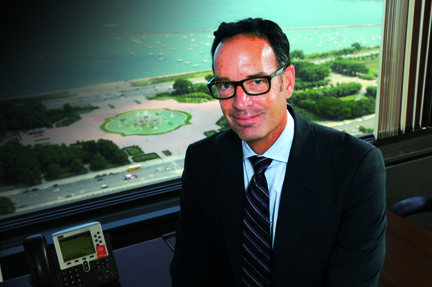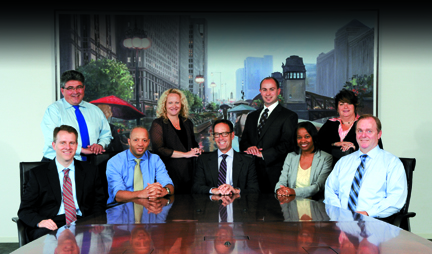 |
 |
 |
Keeping it legal
Market leader CNA delivers underwriting expertise and risk control to law firms of all sizes By Elisabeth Boone, CPCU Can you spell "litigious"? Not everyone can, but that doesn't stop them from filing lawsuits—even against the attorneys who represent them in cases involving anything from a neighborhood dispute to criminally negligent homicide. Even as they engage in the practice of their particular specialty, lawyers must prepare to defend themselves against suits filed by disgruntled clients—and others. According to CNA Insurance, a leading U.S. writer of lawyers professional liability insurance, about 2%-3% of practicing lawyers in the country are likely to face an allegation of professional malpractice in any given year. What's more, the insurer notes, law firms of all sizes are vulnerable to claims, no matter where they are located or what kind of law they practice. To protect themselves in the event that they're sued, more than 150,000 lawyers in 49 states turn to CNA, which for more than 50 years has been delivering lawyers professional liability coverage along with a comprehensive suite of risk management services. From small-town sole practitioners to large specialty firms, CNA provides insurance tailored to specific needs and manages a book of business worth more than $300 million in premium. The insurer also offers business owners and workers compensation coverage to the law firms it insures.
As CNA's vice president of underwriting for lawyers professional liability, Michael Furlong, JD, is eminently qualified to comment on key trends in the legal environment and their impact on claims. He joined CNA in 2010, and his background encompasses more than 20 years' experience in the professional liability field. "One significant change I've observed over the years is that there's a greater willingness on the part of clients to pursue claims against their attorneys for unsatisfactory outcomes," Furlong remarks. "We're also seeing an increasing tendency for one law firm to sue another, as well as more claims being brought against law firms by non-clients." These trends, he points out, underscore the need for law firms to develop and implement strong risk management measures to forestall claims and suits. "The importance of careful client selection is paramount, and clear client communication and documentation are absolutely critical to the successful practice of law," Furlong asserts. Each year, he notes, the American Bar Association conducts a study of claims against lawyers by area of practice. "Generally the top five practice areas are pretty consistent in terms of the frequency of claims," he says. "Our results at CNA are similar to those of the ABA study. "The number one practice area for claims, especially during the economic downturn, has been real estate law," Furlong says. "The collapse of the residential real estate market triggered an influx of claims in 2007 and 2008. First we saw claims related to errors in titles, and shortly thereafter came a deluge of claims based on the steep decline in property values." As the crisis spread to the commercial side, he comments, clients who experienced similar adverse outcomes began to sue their lawyers. Ranking second highest in terms of claims is plaintiff work; also consistently in the top five are collections and bankruptcy, family law, and estates, trusts, and probate. With regard to severity, Furlong says, "We've seen a big uptick in claims related to commercial transactions among both our large firms and our smaller firms. Again this trend has been driven by the economic downturn. Many claims allege errors in the drafting of contracts; another cause of severity is conflict of interest claims. We're also seeing an increase in claims against defense firms."
Risk awareness When it comes to preventing claims, a critical factor for every law firm is awareness of the risks it faces and their potential impact. Because lawyers are highly educated professionals, it's tempting to assume that they have a high level of risk awareness—but Furlong says that's not necessarily the case. "It's all over the board," he says. "In general, younger lawyers may be less educated about their professional liability exposures and the challenges they represent. Law schools are doing a better job in this regard, but for the most part younger lawyers must develop this awareness through their practice. As an insurer, we try to raise awareness of the exposures that law firms face, and overall I think our industry is making a strong effort on this front," Furlong remarks. "Risk awareness is absolutely critical," he continues, "and it's promoted and emphasized in programs of continuing legal education. A bigger challenge is getting law firms to actually change their behavior by implementing sound risk management initiatives. "For example, we emphasize the importance of engagement letters and of making sure that a documented agreement is in place with regard to the firm's representation of the client," Furlong says. "In our application we ask specifically: 'Do you use engagement letters?' In over 97% of the applications we receive, the lawyers say yes. But when we have a claim and we ask the defense lawyers who represent our insureds to obtain a copy of the engagement letter, they tell us there is no letter. "This shows that there's a clear misunderstanding of what an engagement letter is and why it's so important," he comments. "That's a big challenge for us: not only to continue to drive awareness of the exposures law firms face but also to urge them to implement measures, like engagement letters, that can mitigate risk." CNA recently launched a new Engagement Agreement Initiative to help reduce legal malpractice claims filed against lawyers and law firms. CNA has developed 11 sample templates based on the American Bar Association Model Rules of Professional Conduct. The agreements include illustrative language that attorneys can use in their own engagement agreements.
CNA offers its insured lawyers a comprehensive suite of risk control services that includes seminars, webinars, articles, and risk alerts; risk control guides and practice aids; a Risk Analyzer to analyze professional liability risk; a newsletter, and podcasts. A Lawyers' Toolkit titled "A Guide to Managing the Attorney-Client Relationship" contains sample engagement agreements, letters, and conflict of interest waivers. Insureds also have access to a risk control hotline staffed by lawyers who specialize in legal ethics and law practice management. "We're closely connected with bar associations, and we work with them to put on webinars and seminars and to produce information for their members," Furlong explains. "Those relationships are a key component of our operation." He adds that CNA has nine state bar endorsements for its insurance programs. CNA provides lawyers professional liability insurance for firms that range in size from small-town sole practitioners to major firms with offices in multiple locations, and coverage is available for virtually every area of practice. Each insured is assigned a dedicated agent who in most cases has decision-making authority. The insurer's program for firms with 35 or more attorneys is provided in partnership with an exclusive national network of licensed property and casualty agents who specialize in lawyers professional liability insurance. The Small Lawyers Program (Program Law) for firms with one to 34 attorneys is provided through a network of 18 managing general underwriters that CNA designates as state administrators. "They have solicitation and underwriting authority on behalf of CNA, and they have a statewide exclusive for smaller law firms," Furlong explains. "The state administrators are experts in lawyers professional liability. They're well connected with their state bar associations, and they maintain a strong local presence." At their discretion, the MGUs can accept sub-produced business from retail agents and brokers. "The two distribution models we use are best in class and work very well for our insureds and our company," Furlong asserts. "These partners are a vital component of our success in lawyers professional liability." Earlier this year, CNA announced the consolidation of its Program Law and Large Law Firm underwriting units into a unified department to serve law firms of all sizes. "These units were basically two separate businesses within CNA's professional liability division," Furlong says. "We decided to consolidate the units in order to maximize our capabilities. We're bringing our underwriting, claims, actuarial, and risk control teams together to better serve all of our insured law firms. We'll still have dedicated teams to serve the smaller firms in our Program Law segment, and we'll continue to have a dedicated underwriting team in New York that is focused on our large law firm clients. "A big opportunity for us in the consolidation is to strengthen our service to mid-sized law firms," Furlong adds. "We believe these insureds will benefit from the mix of resources our combined unit can provide." In the challenging market for lawyers professional liability, Furlong is confident of CNA's ability to maintain its leadership position in a competitive environment. "With our underwriting expertise, responsive products, focus on risk control, and strong relationships with the bar, we believe we are well positioned to meet the needs of both current and future insureds," he declares. For more information: CNA Insurance Lawyers Professional Liability Web site: www.lawyersinsurance.com
|
|||||||||
| |||||||||
| ©The Rough Notes Company. No part of this publication may be reproduced, translated, stored in a database or retrieval system, or transmitted in any form by electronic, mechanical, photocopying, recording, or by other means, except as expressly permitted by the publisher. For permission contact Samuel W. Berman. |



